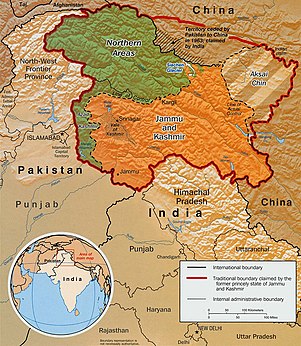
Summary
Chumik Glacier is located in the Siachen region. Located on the west of Saltoro ridge,[1] it is a 4-mile-long offshoot of the Bilafond Glacier.[2]
| Chumik Glacier | |
|---|---|
 Chumik Glacier Location in Pakistan  Chumik Glacier Chumik Glacier (Pakistan) | |
| Type | Mountain glacier |
| Location | Karakoram range, Gilgit-Baltistan, Pakistan |
| Coordinates | 35°13′1.2″N 76°54′32.4″E / 35.217000°N 76.909000°E |
| Length | 23 km (14 mi) |
  History editIn military terminology, Chumik is a minor sub sector of Bilafond Sub Sector,[3] near Gyong La. In March 1989, Indian Army launched the Operation Ibex to seize the Pakistani post overlooking the Chumik Glacier. The operation was unsuccessful at dislodging Pakistani troops from their positions. The Indian Army under Brig. R. K. Nanavatty then launched an artillery attack on Kauser Base, the Pakistani logistical node on Chumik Glacier. The destruction of Kauser Base induced Pakistani troops to vacate their Chumik posts just west of Gyong La, and Operation Ibex concluded.[4] Chumik Glacier to this day is under the control of Pakistani forces, the Pakistani forces are stationed on a post called "Sher Post" which is perched on a ridge at the head of the Chumik Glacier at 19,000 feet.[5] See also edit
References edit
| |


